Questioni have had a green iguana for about a week and i grated up broccoli carrots, parsnips, acorn squash, collard greens, green beans, & yucca root. is that ok for him to eat?
AnswerBroccoli and carrots aren't really ok for iguanas. A diet that has broccoli in large amounts or on a regular basis can lead to thyroid problems as that it interferes with iodine uptake. Carrots are very high in sugars and oxalate acids. The acids interfere with calcium absorption. The rest of the foods, especially the collards and squash are great for everyday use. The other foods can be fed in a smaller amount in the "good mix" which is listed below in the care sheet I've included to help you do the best for your iguana.
If you have any questions, please be sure to ask.
BASIC CARE of GREEN IGUANAS
Iguanas have many, many special care needs...when those needs are not met, iguanas will suffer in many ways...which can include metabolic bone disease, kidney and liver disease....and death...its important to give an iguana all the recommended care to help them thrive in captivity....below is the basic care an iguana needs...anything less and they will not do well in captivity.. Its really a good idea to read up on the care of an animal before you purchase it, but...you asking for help here is a great start to getting the iguana on the right track.... If their care is not right...they will not be active or eat..PLEASE read the entire care sheet...and print it out if needed...also be sure to read the enclosed links I listed at the bottom.....
BASIC CARE OF THE GREEN IGUANA:
HOUSING:
Don't let the pet store tell you that an ig will only grow as
big as the cage it is in!!! That's NOT true!!! Don't waste your money on a
10 gallon tank...that's big enough to bring them home in, but that's about it.
To give you an idea how fast they grow, an iguana will outgrow a 75 gallon
tank within the first year. Start with nothing smaller than a 55 gallon tank,
but, since iguanas are arboreal, a tank does not offer the height an iguana needs.
That's a very good reason to start with a cage
that is bigger.The size that is required for an adult iguana is 6-7 feet high, at least
5-6 feet wide and no less than 3 feet deep.
Its important to remember air circulation and also
that you have to keep the humidity up. Also, that you have to be able
to provide the lighting and heating from the top, so a screen or mesh top
is needed, or a solid top with holes cut out and covered with screen for
the lights to shine through.(the screen covering the opening prevents the
ig from being able to touch the heat source) If not, you will harm your ig health wise.
LIGHTING:
Supplying uvb can be done in a few ways. By special lights
that come in fluorescent tubes or special screw in bulbs
(mercury vapor)that are designed to produce uvb and heat.
The tubes do not produce heat. UVB is needed by the Iguanas
to be able to absorb the calcium in the foods they eat.
With out the uvb, they will develop metabolic bone disease.
With the tubes, they must say that they produce BOTH uvb and
uva. The uvb needs to be 5% or higher. Repti Sun 5.0 and the 10.0
two of the best uvb tubes on the market. The Repti Glo 8.0's are a great source for uvb. There are tubes
that say ''full spectrum'' but they do not produce any uvb.
These need to be positioned 6-8 inches over the iguana so
that they get the uvb that is needed. The tubes need to be replaced every 6-9 months as that they stop producing UVB long before they stop producing light.
Using a fixture that holds two uvb tubes of at least 3 feet in length will provide adequate uvb for your iguana. Do not use coil lights that are sold as that they do not produce the uvb in the fashion needed for iguanas.
On the mercury vapor , they also produce heat. They also
produce the uvb and uva. The best on the market now are the
Mega Rays.(http://www.megaray.com) The distance from these are greater
than the uvb tubes and the directions must be followed that
are listed for the light. When using the mercury vapor
lights, you don't need to have one light for uvb and one for
heat. The Mercury vapor lights provide both.
For daytime heat, if using the tube uvb, regular household
incandescent light bulbs produce heat. The wattage will
depend on the size of your iguanas enclosure. and the room temperature.
Of course, the best uvb is from the
sun and if you are in an area that you are able to take your iguana outside in a proper enclosure, (Never a tank or enclosed, solid cage)
.
BASKING AREA TEMPERATURES:
Igs MUST HAVE a basking light...they digest their
food by the heat.
This light/heat can be provided by a regular household light bulb that
produces heat.(or if using a mercury Vapor light as mentioned above)
Depending on the size of the cage, you may need
anywhere from a 60 watt to a 100 watt bulb.
The basking area temps must be maintained at about 92 to 96 gradient ...no lower..no higher...
they NEED the heat to digest their food!! If the temperatures are too low,
digestion is slowed, too high and the food digests too fast and nutrition is not utilized as it should be.
This, again, is for 12 hours of daylight (the same time your UVB lights are on).
You can place this bulb in a silver dome fixture(be sure it has the ceramic socket) and it MUST be placed
so that your ig cannot climb on it..or touch it. On top of your screen
cage is safe but..if your ig likes to hang from the top of the
cage..you will have to raise it up some how to prevent burns.
Remember..if you must move it, monitor the temps again!!!!!!
This cannot be stressed enough. In order to maintain those temps,
it is VERY important to use thermometers. Using a GOOD digital is a necessity!!
A THERMOMETER IS A MUST!! It needs to be at the igs level....where he lays in the basking
area to see what the temp is there...if your thermometer is NOT where he lays,
you will get an improper reading for his basking area and you will burn
your ig (watch for panting or mouth gaping open - signs of overheating)or the temperatures
in the basking area will not be in the correct range. The best are the digital ones that have the probe. Some also give the humidity reading along with the temperature in two different areas.
You will need a basking shelf or branch. The placement of this depends
on what height you need to maintain the temps mentioned above and keep your iguana within the recommended
distance of the uvb source. Be sure to make it at least twice the width of the ig. Keep in mind the distance
the UVB light needs to be from the ig also. This is almost the hardest
area of the cage to get correct..it requires a lot of monitoring of
the temps until YOU ARE SURE they are correct.
WATER:
Keep a shallow dish of fresh water for your ig at all times.
Some igs will 'poo' in their water dishes, so you may have to change
it more than once/day. Providing a 2nd water source, such as some type of low pan for a small ig,
or a cat litter box(filled with water) for an adult ig is a good idea.Keep water shallow enough that your ig can touch
the bottom freely, as too many younger igs have been known to actually
drown!
HUMIDITY:
Igs MUST HAVE humidity. They are of the Tropical Rain Forest.
This means you need a humidity gage. Humidity needs to be high!!!
Almost raining!! 60% is the minimum... I wouldn't go above 70-75%, although most
of us
can't get that high...that's why misting your ig several times a day
helps. You can use humidifiers or vaporizers can be necessary to get a humidity level that is needed.
TEMPERATURES:
in the entire cage need to be varied. The basking
area
(branch or shelf nearest the heat source) has already been covered.
You need to have a gradient temp in the area of 75-96. Sound confusing? Basically, you need the "basking" area, a middle temp area and a cool
area. Basking area..92-96.....mid range gradient temp..88-92 (Ambient)and cool side 75-84.
Igs cannot regulate their body temps. They rely on the sun
(natural or by way of light bulb) and the shade (cooler area of the cage)
to do that.
NIGHT..... LIGHTS OUT!!!!!! At night, if
the temperatures drop below 75-80 degrees(depending on the iguana age)
you need to provide a heat source in the form of a ceramic
heat emitter(which can also be used during the day) or a
special nighttime bulb(red or deep purple) that does not
produce any bright white light.Some iguanas do not like the colored lights and do try to hide from them. Its up to you to see this and switch to a ceramic heat emitter to prevent your iguana stressing
DIET:
Iguana Iguanas are herbivores.... They DO NOT need animal
protein, they cannot digest it... it will KILL them!! (Kidney disease)
Basically, the diet needs to consist of Collard Greens, mustard greens, turnip greens,
dandelion greens,escarole, endive, chicory, arugula,(torn in pieces smaller than
their head) winter squash (butternut or acorn squash), parsnips
(grated or shredded) all placed in a shallow dish. (This is not
a complete foods list, but is a good start.)
There are 'good' foods and foods for treats (those
used only once in awhile). Fruits are treats..to be given a few
times a week. (This doesn't mean that you cannot give your ig a
piece of fruit every day..one small piece a day is fine.) Again,
I cannot stress enough the importance of diet. NO COMMERCIAL
prepared ig food..no bugs, worms, tuna, chicken, monkey biscuits,
dog or cat foods, eggs, cottage cheese... NO animal protein!!!!!
SUBSTRATES:
This is what you use on the floor of your igs enclosure.
DO NOT USE anything that is bark, litter,chips...no loose substrates!!...Many are toxic
and more so, your ig will ingest these items and it will KILL them.
You can use paper bags, newspaper, paper towels, no pile carpeting or towels(wash first,and be sure there are no loose strings )
HEAT ROCKS KILL!!!!!!!!!!!!!!!!!!!!!!!!!!
...they can overheat, they cause burns (igs cannot feel
the heat) they will KILL... if you have one and you ig loves it..
cut off the cord and place it on his basking shelf and it will absorb the heat of the basking light. Never use heat rocks or heated caves!!!!
This list is by no means complete!!!! Below are listed some very good informational sites.
They will be with us for 15-20 plus years with proper care and
a little luck. Providing them with the proper needs will help them live
a long, healthy, and happy life.
Remember, we are the ones that pulled them out of the rainforests..
it's our job to give them as close to a natural habitat as possible.
http://www.iguanaden.org/
http://www.greenigsociety.org/
http://anapsid.org/
http://groups.yahoo.com/group/BabyIguana/ a yahoo group dedicated to raising baby iguanas
Find a Vet before you need one!!! Reptiles need Vets trained to treat them..to find one in your area:
http://www.anapsid.org/vets/
The information contained in the caresheet was originally written by me for use at the iguanaden website(2003) and also in the book"The Iguana Den's Care and Keeping of Giant Green Iguanas"(2005)

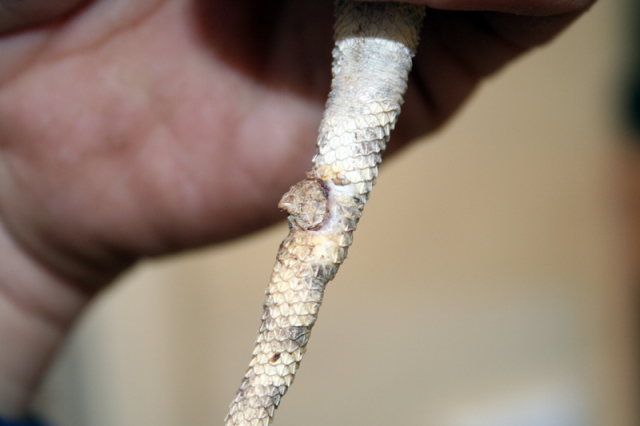 Egyptian Agama
Question
Egytian Agama tail 1
Hello Diane
I recently
Egyptian Agama
Question
Egytian Agama tail 1
Hello Diane
I recently
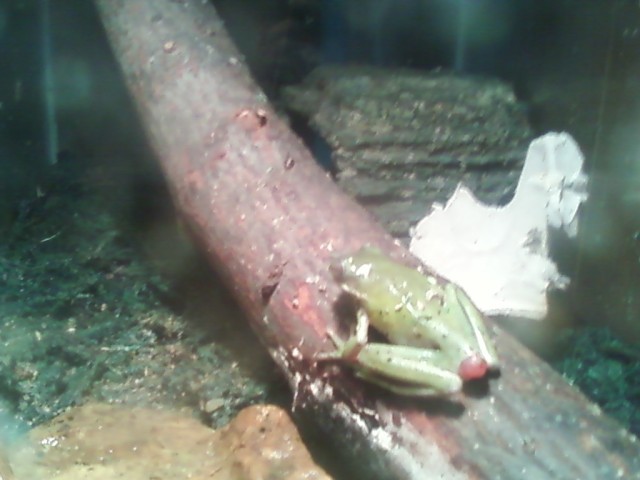 Whats wrong??
Question
Bump thing...
I have a tank full of Barking Tr
Whats wrong??
Question
Bump thing...
I have a tank full of Barking Tr
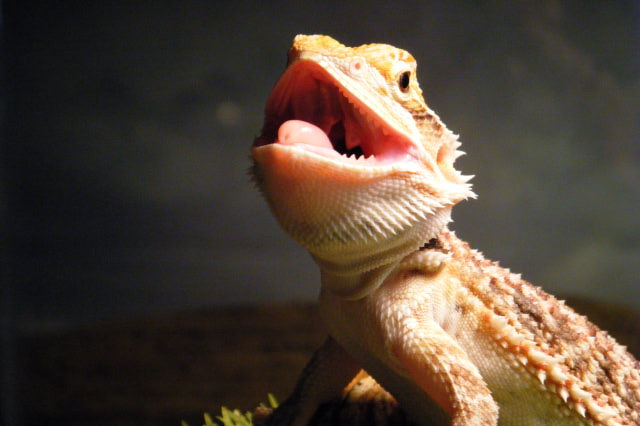 MBD in Bearded dragon
Question
our baby Hoodoo
Hi there, we are desper
MBD in Bearded dragon
Question
our baby Hoodoo
Hi there, we are desper
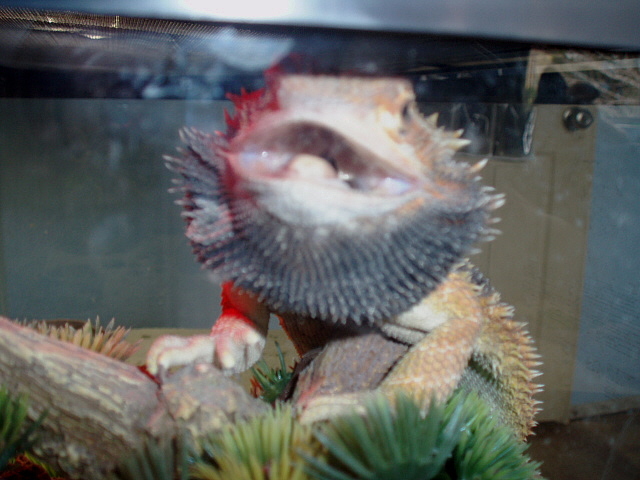 Beardier Flaring Beard
Question
Ryuu
I have a Bearded Dragon, probably hitting
Beardier Flaring Beard
Question
Ryuu
I have a Bearded Dragon, probably hitting
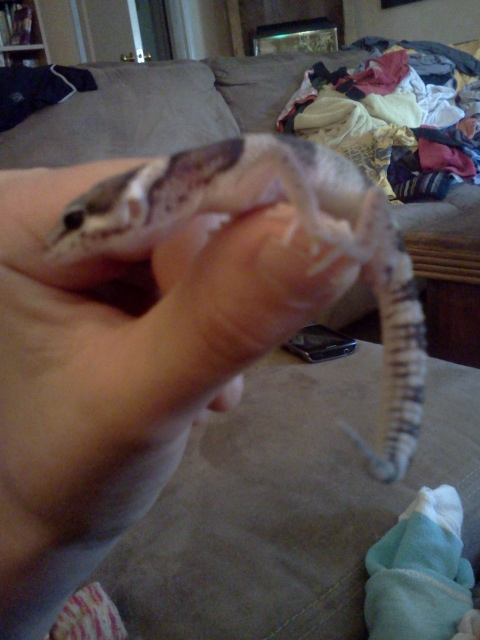 baby leopard gecko morph
Question
Rocky
I just got a super cute baby geck
baby leopard gecko morph
Question
Rocky
I just got a super cute baby geck